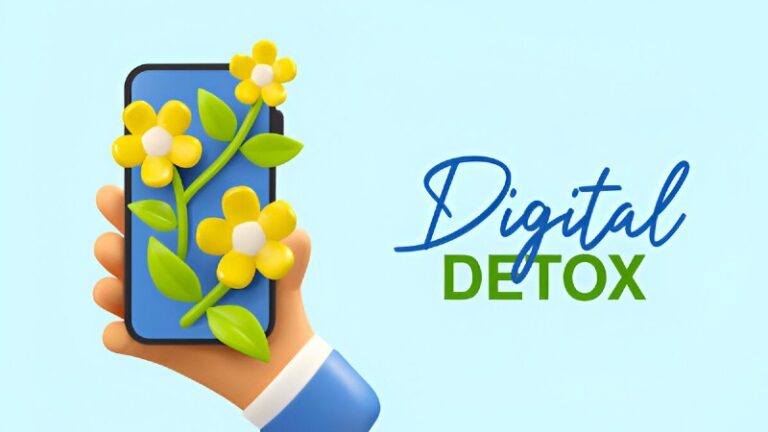In today’s hyper-connected world, our smartphones, laptops, and social media apps constantly demand our attention. While technology has undoubtedly made life easier and more connected, overuse can lead to stress, reduced focus, and even mental health challenges. A digital detox a structured break from screens can help you regain balance, clarity, and energy.
Why You Need a Digital Detox
Before diving into a plan, it’s essential to understand why a digital detox is valuable:
- Reduced Stress and Anxiety: Constant notifications and information overload can elevate cortisol levels, increasing stress.
- Improved Focus: Studies show that the average human attention span has decreased from 12 seconds in 2000 to 8 seconds in 2023 due to constant digital distractions.
- Enhanced Relationships: Disconnecting from devices allows more meaningful interactions with family and friends.
- Better Sleep: Blue light from screens interferes with melatonin production, disrupting circadian rhythms.
Statistics show that the average adult spends over 6 hours per day on screens, which is linked to higher rates of anxiety, depression, and social isolation. A structured detox can help reset your habits and restore balance.
The Principles of a Successful Digital Detox
A digital detox isn’t about abandoning technology entirely; it’s about mindful usage. Here are key principles to follow:
- Intentionality: Decide why you want to detox and what you hope to achieve.
- Boundaries: Identify which apps or devices consume most of your time and set limits.
- Offline Engagement: Replace screen time with activities that promote creativity, mindfulness, or social connection.
- Gradual Change: Avoid going cold turkey unless necessary; incremental reduction is more sustainable.
Digital Detox Benefits You Might Not Expect
While most know the basic benefits of digital detoxing, such as improved focus or sleep, there are lesser-known advantages that can transform your daily life:
- Boosted Creativity: Without constant digital input, your brain has space to generate ideas and solve problems.
- Mindful Eating: Fewer distractions at meals improve digestion and awareness of hunger cues.
- Financial Awareness: Reducing online shopping and app purchases can lead to noticeable savings.
- Emotional Regulation: Less exposure to social media comparison reduces mood swings and envy.
7-Day Digital Detox Plan
This plan gradually reduces screen time and encourages offline activities for maximum effectiveness.
| Day | Focus | Activities & Examples |
|---|---|---|
| Day 1 | Set Intentions & Boundaries |
|
| Day 2 | Reduce Social Media |
|
| Day 3 | Implement Tech-Free Zones |
|
| Day 4 | Limit Work-Related Screens |
|
| Day 5 | Engage in Nature |
|
| Day 6 | Full Digital Fast |
|
| Day 7 | Reflect & Plan Forward |
|
Offline Activities to Replace Screen Time
Replacing screen time with meaningful activities is key to sustaining a digital detox. Consider the following examples:
- Physical Exercise: Walking, cycling, swimming, or yoga.
- Creative Projects: Writing, painting, music, or DIY crafts.
- Social Activities: Coffee meetups, board games, or volunteer work.
- Mindfulness Practices: Meditation, journaling, or breathing exercises.
Tips for Maintaining Digital Balance After the Detox
To ensure the benefits last beyond the 7-day plan, follow these strategies:
- Set App Limits: Use built-in tools to restrict daily usage.
- Create Weekly Tech-Free Times: Dedicate a few hours weekly to unplug.
- Prioritize Real-Life Interactions: Schedule regular in-person meetings.
- Use Mindfulness Prompts: Pause before opening apps and ask if it’s necessary.
Measuring the Success of Your Digital Detox
Tracking improvements helps reinforce the positive impact of unplugging. Metrics can include:
| Metric | Pre-Detox | Post-Detox |
|---|---|---|
| Daily Screen Time (hours) | 6+ | 3–4 |
| Sleep Duration (hours) | 6–7 | 7–8 |
| Focus & Productivity Score* | Low | Moderate–High |
| Stress Level (1–10) | 7–8 | 4–5 |
Conclusion
A 7-day digital detox is more than just taking a break from screens; it’s an opportunity to reclaim your attention, enhance your mental well-being, and reconnect with the world around you. By following a structured plan, engaging in offline activities, and establishing mindful habits, you can create a healthier relationship with technology that lasts well beyond a single week.
Remember, the goal isn’t to eliminate digital tools entirely they are valuable for communication, learning, and work but to ensure they serve you rather than control you. Start your detox today, and experience the clarity, focus, and peace that come from intentional digital balance.
Frequently Asked Questions (FAQs)
What is a digital detox?
A digital detox is a deliberate period of time during which you reduce or eliminate the use of electronic devices like smartphones, computers, and social media to improve mental clarity, reduce stress, and enhance overall well-being.
How long should a digital detox last?
Digital detoxes can vary from a few hours to several weeks, depending on your goals. This guide focuses on a structured 7-day plan to gradually reduce screen time while building sustainable habits.
What are the benefits of a 7-day digital detox?
A 7-day digital detox can improve focus, reduce stress, enhance creativity, promote better sleep, strengthen relationships, and help develop a healthier relationship with technology.
Can I still use my phone for work during a digital detox?
Yes. A digital detox focuses on mindful use, not complete avoidance. You can limit work-related screen time to scheduled periods while avoiding unnecessary apps, notifications, and social media.
How can I maintain digital balance after the detox?
Set app limits, create weekly tech-free times, prioritize offline social interactions, and practice mindfulness before opening apps to maintain long-term digital balance.


